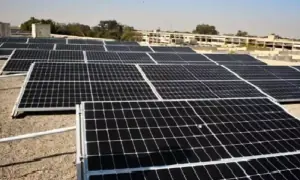Sindh snubs Nepra to set up own electricity regulator to get job done
Sindh has decided to go ‘rogue’ on Islamabad by setting up its own Sindh Electric Power Regulatory Authority so that people receive power supplies more equally and “energy poverty” is eliminated in the province.
If this works, it would be a historic decision as people in villages and small settlements in certain areas barely get any electricity during the day. They have, where possible, invested in solar over the years. A village outside Larkana, for example, called Khairo Dero gets power just one hour a day.
As of 2021, K-Electric has a capacity to produce around 2,267 MW from a mix of thermal, hydro, and solar power plants
It is frustrating because we’ve been hearing that Sindh can produce lots of power (coal, solar, and wind). But, Energy Minister Imtiaz Shaikh told the Cabinet that the province’s power projects, especially for renewables, face constraints within the national framework. He was being polite, or the press handout was bleached of invective.
The constraints are because Sindh struggles with the Indicative Generation Capacity Expansion Plan 2021 (IGCEP 2021). The National Transmission and Dispatch Company or NTDC makes the plan, which Nepra approves. This plan makes it possible for private and government power projects to happen.
Sindh Cabinet has today approved the draft law establishing the Sindh Electric Power Regulatory Authority. This is a landmark decision of #SindhGovt which will enable us to provide cheaper electricity to the people of our province pic.twitter.com/cZEZusEDyG
— Murtaza Wahab Siddiqui (@murtazawahab1) April 12, 2023
The CM said that it was essential that Sindh had a legal, policy, and regulatory framework so that power can be made and send to homes to ensure no one is left out.
Under the 18th Amendment to the Constitution, the power to levy taxes on the consumption of electricity and the power to determine the tariff for its distribution within a province was given to the provinces.
Nepra’s law (under Section (7)(4) of the NEPRA Act 1997) says that the provinces can build power houses and grid stations and lay transmission lines for use within the province and determine the price at which they want to distribute electricity.
The idea behind this bill is that all power companies should also be under the provinces instead of being controlled from Islamabad. This will be a big breakthrough and it will affect K-Electric as well.
But there is a hitch.
What CM House did not go into were the details of an old dispute between WAPDA, NEPRA and itself. Aaj News senior reporter Qazi Asif explained that Wapda has not been ready to let Sindh transfer power through its national transmission lines (from coal to wind and solar energy) and Nepra is not ready to fix a tariff or price in many cases. WAPDA was not ready to allow Thar power to use their transmission lines to transport electricity to Karachi, for example. K-Electric had wanted to buy Thar and wind power but the problem was with the lines.
So in some ways the load shedding could be addressed if Sindh could find ways to get electricity to where it is needed.
The cabinet meeting was attended by ministers, advisors, special assistants, Chief Secretary Sohail Rajput, Chairman P&D Hassan Naqvi, PSCM Fayaz Jatoi.
What is the IGCEP?*
The Indicative Generation Capacity Expansion Plan (IGCEP) is a planning document that outlines the projected power demand and the required capacity addition for the electricity sector in Pakistan. The IGCEP 2021 is the latest version of this plan, which was released by the NTDC.
The IGCEP 2021 aims to provide a roadmap for the development of the power sector in Pakistan by assessing the future electricity demand and identifying the necessary capacity addition from various sources such as thermal, hydro, renewable, and nuclear power. The plan considers various scenarios, including different economic growth rates, fuel prices, and environmental regulations, to provide a range of projections for capacity additions.
The plan identifies a significant increase in electricity demand over the next decade and recommends a capacity addition of around 37,000 MW by 2047. The plan also emphasizes the development of renewable energy sources and aims to increase the share of renewable energy in the energy mix to 30% by 2030.
The IGCEP 2021 is an essential tool for policymakers, investors, and stakeholders in the power sector to plan for the future and ensure the availability of reliable and affordable electricity in Pakistan. The plan is updated periodically to reflect the changing energy scenario in the country and to ensure that it remains relevant and effective in achieving its objectives.
What did the CM mean when he said there were constraints?
Sindh has potential to work in renewable energy, particularly wind and solar. However, there have been some constraints faced by power projects that have hindered their development and non-inclusion in the IGCEP 2021.
One main constraint is the lack of adequate transmission infrastructure. The existing transmission lines are often congested, and there is a need for significant investment in upgrading and expanding the transmission network to support the development of new power projects, including renewable energy projects.
Another constraint is the lack of a conducive regulatory environment. The regulatory framework for renewable energy projects in Pakistan has improved in recent years, but there is still a need for further reforms to address issues related to land acquisition, permitting, and interconnection.
Moreover, there may be challenges in the planning and coordination between the federal and provincial governments, which may lead to certain provinces or regions being overlooked in national-level planning documents such as the IGCEP.
*Generated by AI and not written by a subeditor
This is a developing story
For the latest news, follow us on Twitter @Aaj_Urdu. We are also on Facebook, Instagram and YouTube.















Comments are closed on this story.